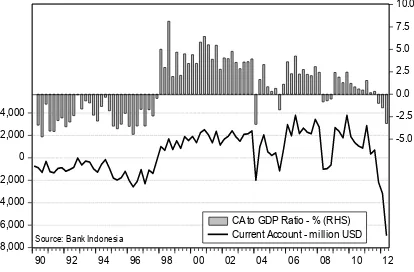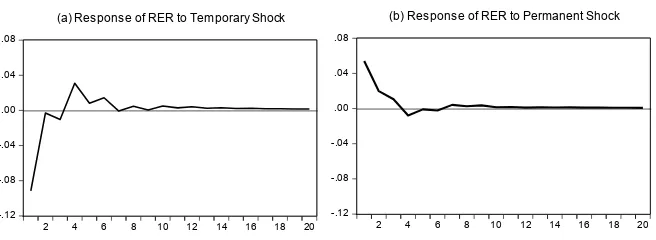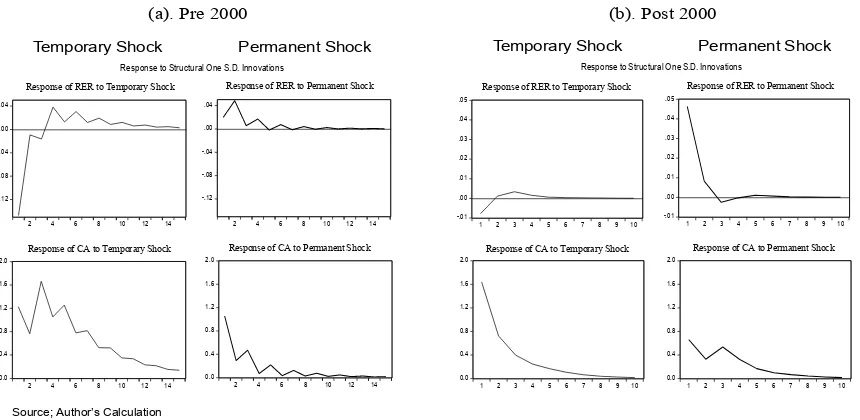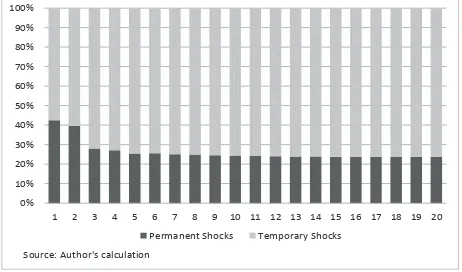Procedia Economics and Finance 5 ( 2013 ) 20 – 29
2212-5671 © 2013 The Authors. Published by Elsevier B.V.
Selection and/or peer-review under responsibility of the Organising Committee of ICOAE 2013 doi: 10.1016/S2212-5671(13)00005-1
International Conference on Applied Economics (ICOAE) 2013
Current Account and Real Exchange Rate Dynamics in
Indonesia
Yoga Affandi
a,* and Firman Mochtar
aaBank Indonesia, Jl. MH. Thamrin No.2, Jakarta-10350, Indonesia
Abstract
We analyze the role of both permanent and temporary factors in affecting the Indonesian current account and real
exchange dynamics before and after 2000. Adopting Lee and Chinn (1998, 2006) approach as well as Chinn et al (2007),
two results stand out. First, we confirm that the behavior of the real exchange rate has altered since 2000. Identifications show that permanent shocks are the primary causes for the movement of the real exchange rate after 2000, while in the period before 2000, the Indonesian real exchange rate changes are characterized by greater dominance of temporary shocks. The apparent change in the real exchange rate behavior may be strongly justified by the implementation of free-floating exchange rate system since August 1997. Second, the shift of the real exchange rate behavior after 2000 does not necessarily affect the current account dynamics. Empirical evidence confirms that the variance of current account post 2000 remains largely due to temporary shocks. Albeit having increasing influence, permanent shocks have insignificant effect in explaining fluctuations of the current account. In this sense, the current account surplus after 2000 is attributed largely to nominal variables such as price increase, while the impact of productivity improvement is still limited.
© 2013 The Authors. Published by Elsevier B.V.
Selection and/or peer-review under responsibility of the Organising Committee of ICOAE 2013.
Keywords:
Current Account; Real Exchange Rate; Asian Crises
1.Introduction
There have been significant differences when comparing Indonesia’s current account dynamics before and after the 1997/98 Asian economic crisis. Prior to 1998, Indonesia’s current account had typically run in deficit,
* Corresponding authors. Tel.: +62-21-3818385; fax: +62-21-3502030. E-mail address: [email protected]; [email protected].
© 2013 The Authors. Published by Elsevier B.V.
Selection and/or peer-review under responsibility of the Organising Committee of ICOAE 2013
ScienceDirect
Open access under CC BY-NC-ND license.
reaching close to 3 % of GDP (Figure 1). Nevertheless, the country’s current account shifted into surplus after 1998 and hitting a record of 2.5 % of GDP in 2004 before shrinking back to deficit of 2.7 % of GDP in 2012.
Figure 1. Indonesia’s Current Account
What component caused the current account to shift after the 1998 crisis? Given the services account has been persistently deficit since the Asian Crisis, one explanation therefore lies on the trade balance. Data depicted that Indonesia’s trade balance surplus over the last decade was mainly related to the strong commodity exports. However, when the commodity price boom went into bust in 2012, the surplus narrowed. Meanwhile, in non-commodity trade balance, imports have surpassed exports since 2006, making the small surplus turned into deficit with the tendency to grow larger. Two main reasons are behind this: the weakening performance of export notably in manufacturing sector and high import growth due to strong domestic demand.
Another approach to explain current account dynamic is that there is either permanent or temporary factor behind the current account behaviour. Question arises when we relate them to the fact that structural changes have shifted the Indonesian socio-economics and political landscapes after the 1997/98 crisis. As illustration, Bank Indonesia has adopted a free-floating exchange rate system since August 1997 and implemented inflation targeting to be a framework for monetary policy in 1999 (Ananta et al, 2011). Furthermore, on fiscal policy, the government has committed to fiscal consolidation, aimed at a sustainable budget and implemented fiscal decentralization since 1999. In general, it is reasonable to suggest that the aforesaid changes may affect current account dynamics post 1997/98 crisis.
This study attempts to reveal the later approach i.e. to investigate the relationship between structural changes in Indonesia and shift in current account patterns in the periods before and after the Asian crisis. For that purpose, we will classify probable factors affecting current account dynamics into two specific groups: permanent and temporary factors. Permanent factors are the ones structurally affecting current account in the long term such as the supply side, productivity, as well as changes in preferences. Clarida and Gali (1994) denoted shocks in these structural factors as real shocks, that eventually affect supply side of the economy such as natural disaster or technology. On the other hand, temporary factors are those that affect current account only in the short run such as nominal variables like prices, money supply, and nominal exchange rate.
By adopting Lee and Chin (1998, 2006) approach as well as Chin and Lee (2009), this study has supported two main conclusions. First, real exchange rate behavior, as a factor affecting current account, has significantly changed after 2000. Post 2000, it is evidenced that real exchange rate behavior has been mainly affected by permanent factors, whereas prior to 2000, temporary factors played dominant role. Moreover, it is strongly suggested that the adjustment of real exchange rate behavior was affected by implementation of free
-8,000 -6,000 -4,000 -2,000 0 2,000 4,000
-5.0 -2.5 0.0 2.5 5.0 7.5 10.0
90 92 94 96 98 00 02 04 06 08 10 12 CA to GDP Ratio - % (RHS) Current Account - million USD
float exchange rate regime and inflation targeting framework. Under this policy framework, the role of central bank in foreign exchange market is minimal so that the exchange rate will move according to economic fundamentals. That said, real exchange rate behavior after 2000 was mainly influenced by structural and fundamental changes, rather than nominal factor movement.
On the other hand as second conclusion, the shift in exchange rate behavior post 2000 did not necessarily affect the current account behavior. Identifications showed that current account behavior after 2000 remains due to the dominant role of temporary variables. The role of permanent factors, despite has been intensified, remain smaller than temporary factors in affecting current account dynamic post 2000. Therefore, we can infer that the current account surplus post 2000 was more affected by nominal factors like price level rather than productivity improvement. Accordingly, deterioration of nominal factors will fade away the surplus.
This paper will be divided into four parts. The second part will outline theoretical considerations and empirical testing methods. The third part will present estimation result on the dynamic role of permanent and temporary factors in affecting real exchange rate and current account in 1990-2012. Furthermore, this section will laid out the impact of historical behaviour of both factors to current account and real exchange rate. The final part offers conclusion.
2.Theoretical Survey and Estimation Method
2.1. Theoretical Survey
We adopt Lee and Chin (1998, 2006) approach in modeling the impact of permanent and temporary factors to current account dynamics and real exchange rate. The working model is based on Clarida and Gali (1994) with two variables namely the current account and the real exchange rate. In this approach, both permanent and temporary factors are approximated by permanent and temporary variables and yet shocks at each variable will be classified as real shock and nominal shock, respectively.
Following Lee and Chin (1998), the economy is built based on standard IS-LM model. Equation (1), as the IS equation, explains how real exchange rate ሺݏ௧െ ௧ሻand expectation on real interest rate ሺ݅௧െ ܧ௧ሺ௧ାଵെ ௧ሻሻ affect demand for output (ݕ௧ௗሻ. Meanwhile, equation (2) shows the demand for real money
ሺ݉௧െ ௧ሻ as a function of output ሺݕ௧ሻ and nominal interest rate ሺ݅௧ሻ. Equation (3) is the expression for the
interest rate parity, which states that nominal interest rate is determined by the difference between exchange rate at time t ሺݏ௧ሻand market expectations of future exchange rate ሺݏ௧ାଵሻ. Furthermore, equation (4) presumes that the price level ሺ௧ሻ will move gradually toward its long run equilibrium ሺ௧ሻ.
ݕ௧
ௗൌ ߟሺݏ௧
െ ௧ሻ െ ߪሺ݅௧
െ ܧ௧ሺ௧ାଵ
െ ௧ሻሻ
(1)
݉
௧െ
௧ൌ ݕ
௧െ ߣ݅
௧(2)
݅
௧ൌ ܧ
௧ሺݏ
௧ାଵെ ݏ
௧ሻ
(3)௧
ൌ ሺͳ െ ߠሻܧ௧ିଵ
௧ ߠ
௧(4)
Finally, the model will be complemented by three other equations as follow:
ݕ
௧௦ൌ ݕ
௧ିଵ௦ ݖ
௧ (5)݉௧
ൌ ݉௧ିଵ
ݒ௧
(6)Equation (5) suggests that the rise in productivityݖ௧, as a real shock, will induce domestic economy to outperform relative to foreign countries. Meanwhile, equation (6) describes stochastic process of the money supply as a nominal variable whereas equation (7) specifies the current account as a function of real exchange rate ሺݍ௧ൌ ݏ௧െ ௧ሻ and economic productivity.
In brief as shown in Lee and Chin (1998), analytical derivation of equation (1) infers that under flexible price, the neutrality of nominal shocks will hold on real exchange rate in the long-run. Accordingly, contribution of nominal shocks in explaining current account is abolished in the long run. Meanwhile, in the short run where the price is not flexible, analytical result shows that money supply increase will depreciate the currency, as described in equation (9). Furthermore, equation (9) implies that in the short run, increase in nominal shock will revamp the current account, as routed in equation (7).
ݍ
௧ൌ
௬ೞ
ఎ
ߤሺͳ െ ߠሻሺݒ
௧െ ݖ
௧ሻ
whereߤ ؠ
ଵାఒఒାఙାఎ (8)
So that డ
డ௩
Ͳ
forߠ ൏ ͳ
(9)డ
డሺି௭ሻ
ൌ െ
ଵ
ఎ
ߤሺͳ െ ߠሻ
(10)డ
డሺି௭ሻ
ൌ െ
ଵ
ఎ
(11)
It is also possible to infer from equation (8) that the effects of technological shock, as a form of real shock, will result in two possible outcomes. However, outcome will vary according to sensitivity of real exchange rate to output and degree of price flexibility, as stated in equation (10). Under a very flexible priceሺߠ ؆ ͳሻ, negative productivity shock (or positive productivity shock to foreign economy) will improve real exchange rate, and vice versa. But, with price rigidity, negative productivity shock will only worsen real exchange rate.
If we put together equations (1) and (5), we can infer that negative productivity shock will appreciate real exchange rate in the long run, as indicated in equation (11). Meanwhile, from equation (7) we can infer the impact of negative productivity shock to current account is ambiguous, both in the short run and the long run.
2.2 Estimation Method
From the above settings, we estimate a bivariate VAR of real exchange rate (ݍ௧) and ratio of current account to GDP (ܾ௧) by imposing long run Blanchard-Quah (1989) restrictions to distinguish between nominal (߳௧) and real shocks (߳௧் ) as follows:
οݍ
ܾ
௧௧
൨ ൌ ܤሺܮሻ οݍ
௧ܾ
௧൨ ቈ
ߝ
௧ߝ
௧ ൌ ܤሺܮሻ οݍ
௧ܾ
௧൨ ܤሺͲሻ ߳
௧߳
௧்൨
(12)
As in Fackler and McMillan (1998), equation (12) can be historically decomposed by transforming the VAR into Vector Moving Average (VMA) so that the reduced-form shocks ሺߝ௧ሻ are also transformed into structural shocksሺ߳௧ሻ. Each variable in our VAR system is then decomposed into deterministic and stochastic components whereas the stochastic component or total components shock is further decomposed into permanent and temporary shocks.
shock. Impact of permanent shock is attributed only to permanent variables while temporary variables react only to temporary shocks. That said, the deterministic value of current account is the long run ratio obtained when both permanent and temporary shocks are eliminated. The permanent current account is obtained when only structural factors are considered. The permanent real exchange rate should be viewed as the reflection of fundamental factors, in which only structural factors affect the exchange rate, while temporary factors such as market sentiment play no role.
3.Data and Empirical Results
3.1. Data
We use quarterly data both for current account to GDP ratio and log of real exchange rate. Using the period of 1990:1-2012:2, both variables are seasonally adjusted using X-12 method. Real exchange rate is constructed as a weighted average of bilateral exchange rate of US, Japan and Euro countries, as major trading partners. Unit root testing on real exchange rate (q) and current account (b) required real exchange rate to be I(1) and the current account to be I(0), respectively. Stationarity test is conducted based on Augmented Dickey Fuller test while 3 period lag lengths for the VAR is chosen based on Akaike Information Criteria (AIC).
To capture any possible impact of structural changes in real exchange rate and current account, first empirical test is done for all sample of 1990-2012. Afterwards, empirical analysis is implemented by dividing the sample into two subsamples covering pre 2000 (1990-1999) and post 2000 (2000-2012). Similar approach is done by Shibamato and Kitano (2012) in order to identify relationship between current account dynamics and real exchange rate for G7 countries.
3.2. Impulse-Response Function Analysis
Impulse response function (and IRF hereafter) shows that our data is broadly consistent with our theoretical background. From figure 2a, we can observe that for the full sample of 1990-2012, temporary shock --represents nominal shock-- will weaken real exchange rate in the short run and lasts until 4 quarters. Meanwhile, figure 2b demonstrates that when price rigidity is present, increase in permanent shock as real disturbances will likely to strengthen the real exchange rate for up to 4 quarters.
Figure 2. (a) Response of Real Exchange Rate to Temporary Shock; (b) Response of Real Exchange Rate to Permanent Shock
-.12 -.08 -.04 .00 .04 .08
2 4 6 8 10 12 14 16 18 20
(b) Response of RER to Permanent Shock
-.12 -.08 -.04 .00 .04 .08
2 4 6 8 10 12 14 16 18 20
(a) Response of RER to Temporary Shock
IRF analysis of current account for full sample of 1990-2012 is also confirming the theoretical prediction. Figure 3a exhibits the impact of temporary shock through nominal disturbances has increased the current account surplus. In this case, the rise of the current account surplus can also be explained by the permanent shock component as shown in figure 3b. Referring to equation (7), evidences as in previous figures indicate that increased productivity explains current account surplus more dominantly than the strengthened real exchange rate.
Figure 3. (a) Response of Current Account to Temporary Shock; (b) Response of Current Account to Permanent Shock
Moreover, figure 4a and 4b display the IRFs for subsamples of pre and post 2000. Evidently, effects of temporary and permanent shocks in both sample groups are unchanged and consistent with the theory. As in the whole sample group, a temporary shock causes deterioration of real exchange rate and improves the current account in both pre and post 2000 (Figure 4a). Additionally, IRFs in both sample groups continue to depict strengthened real exchange rate and increased current account surplus in the event of permanent disturbances as shown in figure 4b.
Figure 4. (a) Response of RER and CA to Temporary Shock, Pre 2000; (b) Response of RER and CA to Temporary Shock, Post 2000
0.00 0.25 0.50 0.75 1.00 1.25
2 4 6 8 10 12 14 16 18 20
Response of CA to Permanent Shock
0.00 0.25 0.50 0.75 1.00 1.25
2 4 6 8 10 12 14 16 18 20
Response of CA to Temporary Shock
Response to Structural One S.D. Innovations
-.12 -.08 -.04 .00 .04
2 4 6 8 10 12 14 Response of D(LREER) to Permanent Shock
-.12 -.08 -.04 .00 .04
2 4 6 8 10 12 14 Response of D(LREER) to Temporary Shock
0.0 0.4 0.8 1.2 1.6 2.0
2 4 6 8 10 12 14 Response of CAGDPRPSA to Permanent Shock
0.0 0.4 0.8 1.2 1.6 2.0
2 4 6 8 10 12 14 Response of CAGDPRPSA to Temporary Shock
Response to Structural One S.D. Innovations
(a). Pre 2000 (b). Post 2000
Source; Author’s Calculation
Temporary Shock Permanent Shock Temporary Shock Permanent Shock
-.01 .00 .01 .02 .03 .04 .05
1 2 3 4 5 6 7 8 9 10 Response of D(LREER) to Permanent Shock
-.01 .00 .01 .02 .03 .04 .05
1 2 3 4 5 6 7 8 9 10 Response of D(LREER) to Temporary Shock
0.0 0.4 0.8 1.2 1.6 2.0
1 2 3 4 5 6 7 8 9 10 Response of CAGDPRPSA to Permanent Shock
0.0 0.4 0.8 1.2 1.6 2.0
1 2 3 4 5 6 7 8 9 10 Response of CAGDPRPSA to Temprary Shock
Response to Structural One S.D. Innovations
Response of RER to Temporary Shock Response of RER to Permanent Shock
Response of CA to Temporary Shock Response of CA to Permanent Shock
Response of RER to Temporary Shock Response of RER to Permanent Shock
3.3. Variance and Historical Decompositions of Real Exchange Rate
Having confirmed the empirical result to the the analytical approach, in this section, we perform variance decomposition analysis to investigate factors affecting real exchange rate and the current account behaviour. For the first case, we investigate the full sample of 1990-2012. Empirical evidence shows that for the full sample period, the Indonesian real exchange rate is largely influenced by nominal variables. This fact is observed in the importance of temporary shock in affecting the variance of the real exchange rate. Variance decomposition results depict that temporary shock accounted for 75 % of the variance of the real exchange rate (Figure 5).
Figure 5. Variance Decomposition: Real Exchange Rate, Full Sample
Nevertheless, variance decomposition displays different results on pre and post 2000 periods. Prior to 2000, temporary shock accounted for 90 % of the variance in real exchange rate (Figure 6a) whereas permanent shock dominates real exchange rate movements after 2000 (Figure 6b).This significant shift can be appropriately explained by the impact of implementation of free-floating exchange rate regime as well as the implementation of inflation targeting framework. In the aforesaid systems, central bank intervention in the exchange rate market is minimalso that exchange rate is maintained at rates that are consistent with economic fundamentals.
Figure 6. (a) Variance Decomposition : Real Exchange Rate, Pre 2000; (b) Variance Decomposition : Real Exchange Rate, Post 2000
0% 10% 20% 30% 40% 50% 60% 70% 80% 90% 100%
1 2 3 4 5 6 7 8 9 10 11 12 13 14 15 16 17 18 19 20
Permanent Shocks Temporary Shocks
Changes in the dominating factor of real exchange rate dynamics after 2000 is also confirmed by historical decomposition analysis. From figure 7a, we can observe that the impact of temporary shock dominates the real exchange rate prior to 2000. Meanwhile, after 2000, the role of permanent shock is the dominant source behind the real exchange rate movement for almost the entire sample period. In contrast, the role of temporary shock is only appeared in certain period in small magnitude (Figure 7b).
Figure 7. (a) Historical Decomposition : RER, Pre 2000; (b) Historical Decomposition REER, Post 2000
3.4. Variance and Historical Decomposition of Current Account
Another outcome that need to be focused to is the leading role of temporary shocks in explaining the current account dynamics. As shown in figure 8, variance decomposition for full sample period (1990-2012) shows that temporary shocks are accounted for 60 % of the variance of current account during the first two quarters and increase to 75 % afterward. Accordingly, permanent shock are only accounted for 40 % of variance in current account in early observation period before subsequently shrinking to 25 %.
Figure 8. Variance Decomposition: Current Account, Full Sample
Plots of variance decomposition for current account for pre and post 2000 is presented in figure 9. Notably, temporary shock track 85 % of the variance of the current account after 7 periods in the pre 2000 sample group (Figure 9a). Furthermore, the variance of the current account is still dominated by temporary shock albeit its declining impact to 78 % in the period of post 2000 (Figure 9b).This evidence can imply that
0% 10% 20% 30% 40% 50% 60% 70% 80% 90% 100%
1 2 3 4 5 6 7 8 9 10 11 12 13 14 15 16 17 18 19 20
Permanent Shocks Temporary Shocks
the size of permanent shock after 2000 tend to grow up to 22 %. Nevertheless, while the variance of current account captures a growing impact of the permanent shock, as a representation of real shock, nominal shock remains the dominant forces in explaining current account variance post 2000.
Figure 9. (a) Variance Decomposition: Current Account, Pre 2000; (b) Variance Decomposition: Current Account, Post 2000.
We now turn to the historical decomposition result for the response of current account to temporary shock. Before 2000, temporary shock play dominant role throughout the sample period, while permanent shock have a very minimal impact in explaining the current account (Figure 10a).This behavior seem continue for the post 2000. As evident in figure 10b, temporary shock still play a leading role in the current account dynamics in Indonesia after 2000, despite some indication of increasing impact of permanent shock in explaining the variance of the current account in 2009-2011.
Figure 10. (a) Historical Decomposition: Current Account, Pre 2000; (b) Historical Decomposition: Current Account, Post 2000.
4.Conclusions
The purpose of this study is to asses possible impact of structural changes on dynamics of Indonesian current account and real exchange rate before and after the Asian 1997/98 crises. Consistent with Lee and
Chinn (1998, 2006) approach as well as Chinn et. al (2007), it is evident that permanent shock --as a
real exchange rate. Paper also find that temporary shock --as a reflection of nominal shock-- at one hand drives the current account surplus while on the other hand worsen the real exchange rate.
Based on those relationships, two results stand out. First, behavior of the real exchange rate has altered since 2000. Identifications show that permanent shocks are the primary causes for the movement of the real exchange rate after 2000, which is different from the behavior prior to 2000 where temporary shocks played dominant role. The apparent change in the real exchange rate behavior is plausible justified by impact of the implementation of free-floating exchange rate system since August 1997.
Accordingly, the shift of the real exchange rate behavior after 2000 does not necessarily affect the current account dynamics. This rises as the second result. Empirical evidence confirms that the variance of current account post 2000 is largely due to temporary shocks. In contrast, permanent shock has insignificant effect in explaining fluctuations of the current account, albeit a small increasing of permanent shock has been documented. Thus, the empirical evidences support the greater dominance of temporary shocks in affecting the variance of the current account after 2000. In this sense, the current account surplus after 2000 is attributed largely to nominal variables such as price increase while the role of productivity improvement remains limited. Indonesian current account reacts strongly to price movement so that large negative nominal shock mostly explains the shrinking of current account, as described in the recent trend.
Acknowledgements
We thank Deasy Ariyanti for great research assistance. The views expressed here are solely our own and do not necessarily reflect those of Bank Indonesia.
References
Ananta, Aris, Muljana Soekarni, and Sjamsul Arifin (2011), “The Indonesian Economy: Entering A New Era”, Bank Indonesia and
Institute of Southeast Asian Studies
Blanchard, Olivier Jean and Danny Quah (1989), “The Dynamic Effects of Aggregate Demand and Supply Disturbances”, American Economic Review, American Economic Association, vol. 79(4), pp. 655-73, September.
Clarida, Richard and Jordi Galí (1994), “Sources of Real Exchange Rate Fluctuations: How Important are Nominal Shocks?", CEPR Discussion Papers 951.
Chinn, M. D, Jaewoo Lee and Robert M. La Follette (2007), “Three Current Account Balances: A Semi-Structuralist Interpretation”,
Santa Cruz Center for International Economics, October.
Fackler, James S. and McMillan, W. Douglas (1998), “Historical Decomposition of Aggregate Demand and Supply in Small Macro Model” Southern Economic Journal, 64, 3, 648-664
Lee and Chinn (2006), “Current Account and Real Exchange Rate Dynamics in G7 Countries”, Journal of International Money and
Finance, 25, pp. 257-274.
Lee and Chinn (1998), “The Current Account and The Real Exchange Rate: A Structural VAR Analysisof Major Currencies“, NBER
Working Paper 6824, April 1998.





